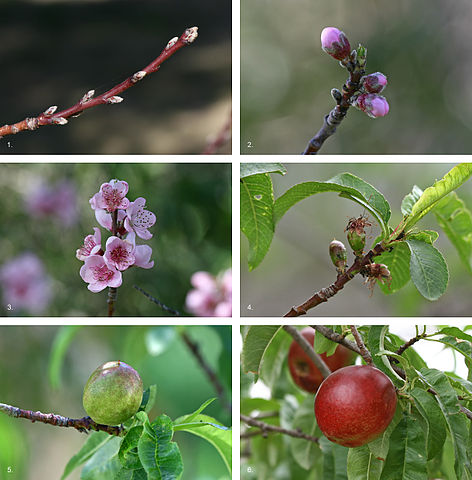
File:Nectarine Fruit Development.jpg

| |
This is a file from the Wikimedia Commons. Information from its description page there is shown below.
Commons is a freely licensed media file repository. You can help. |
| |
This is a featured picture, which means that members of the community have identified it as one of the finest images on the English Wikipedia, adding significantly to its accompanying article. If you have a different image of similar quality, be sure to upload it using the proper free license tag, add it to a relevant article, and nominate it. |
| |
This image was selected as picture of the day on the English Wikipedia for December 11, 2008. |
|
||||||
 |
This image was selected as picture of the day on Wikimedia Commons for 29 August 2008. It was captioned as follows: English: Nectarine ( Prunus persica) fruit development over a 7½ month period, from early winter to midsummer; East Gippsland, Victoria, Australia.
Other languages:
Asturianu: Desendolcu d'una fruta de piescu (Prunus persica) durante un períodu de 7½ selmanes, dende l'entamu del iviernu hasta metada'l branu, n'East Gippsland, Victoria, Australia
Беларуская: Развіццё фрукта нектарына Prunus persica на працягу 7,5 мес.
Català: Creixement i maduració d'una nectarina ( Prunus persica) durant set mesos i mig des del començament de l'hivern fins ple estiu. Est de Gippsland a Victòria (Austràlia).
Česky: Nektarinky ( Prunus persica) vyvíjející se 7½ měsíce; East Gippsland, Viktorie, Austrálie.
Dansk: Udvikling af en nektarin (Prunus persica) i løbet af 7½ måned, fra tidlig vinter til midsommer. East Gippsland, Victoria, Australien.
Deutsch: Entwicklungsstadien eines Pfirsichs ( Prunus persica) von der Knospe zur reifen Frucht über einen Zeitraum von 7½ Monaten vom Winteranfang bis in den Hochsommer beobachtet. East Gippsland, Victoria, Australien.
English: Nectarine ( Prunus persica) fruit development over a 7½ month period, from early winter to midsummer; East Gippsland, Victoria, Australia.
Español: Desarrollo de una fruta de melocotón (Prunus persica) durante un período de 7½ meses, desde el comienzo del invierno hasta mediados del verano, en East Gippsland, Victoria, Australia.
Suomi: Nektariinin ( Prunus persica) hedelmän kehitys
Français : Développement d'une nectarine sur une période de 7,5 mois, du début de l'hiver au milieu de l'été. Est du Gippsland, Victoria (Australie).
Magyar: Az őszibarack (Prunus persica) gyümölcsének fejlődése hét és fél hónap alatt, kora téltől nyárközépig (East Gippsland, Victoria, Ausztrália)
Íslenska: Þroski nektarínu ( Prunus persica) á 7½ mánuðum frá upphafi vetrar til miðs sumars. Tekið í East Gippsland, Victoriu, Ástralíu.
Italiano: Lo sviluppo di una pesca ( Prunus persica) da inizio inverno a metà estate in Victoria, Australia.
日本語: 7ヶ月と半月(冬の初旬から夏の中旬)にかけて撮影された モモの成長 オーストラリア、 ヴィクトリア州、グリプスランドの東方にて
한국어: 천도복숭아( Prunus persica)가 초겨울에서 한여름까지 7개월 반동안 자라는 모습. 오스트레일리아 빅토리아 주 이스트 깁스랜드에서.
Nederlands: De ontwikkeling van een perzik (Prunus persica) over de loop van zeven en een halve maand, van de vroege winter tot het midden van de zomer. Foto's genomen bij East Gippsland in de Australische deelstaat Victoria
Polski: Rozwój owocu brzoskwini przez okres siedmiu i pół miesiąca, od wczesnej zimy do lata. Zdjęcia wykonano w East Gippsland w stanie Wiktoria w Australii.
Português: Nectarina da espécie Prunus persica, imagens de seu desenvolvimento ao longo de sete meses e meio, em East Gippsland, Victoria, na Austrália.
Русский: Развитие плода персика ( Prunus persica) на протяжении 7,5 месяцев.
Svenska: Utvecklingen av en nektarinfrukt ( Prunus persica) under 7,5 månader, från tidig vinter till mid sommar, i Australien.
Türkçe: Tüysüz şeftalinin ( Prunus persica) meyve verme aşamaları
Українська: Персик (нектаринка) ( Prunus persica), розвиток протягом семи з половиною місяців; місцевість East Gippsland, штат Вікторія, Австралія)
中文(简体): 桃( Prunus persica)的7个半月成熟过程,从早冬到仲夏,拍摄于澳大利亚维多利亚州东吉普斯兰。
中文(繁體): 桃( Prunus persica)的7個半月成熟過程,從早冬到仲夏,拍攝於 澳洲 維多利亞州 東吉普斯蘭
|
Summary
| Description |
English: Nectarine (Prunus persica) fruit development over a 7½ month period, from early winter to midsummer; East Gippsland, Victoria, Australia.
Français : Développement d'une nectarine sur une période de 7,5 mois, du début de l'hiver au milieu de l'été. Est du Gippsland, Victoria (Australie).
|
|||||||||||
| Date | Early winter to midsummer, 2007/2008 | |||||||||||
| Source | Own work | |||||||||||
| Author | jjron | |||||||||||
| Permission ( Reusing this file) |
|
File usage
Metadata
| JPEG file comment | This image was processed by Neat Image. NeatImage.com |
|---|
Did you know...?
SOS Children aims to make Wikipedia suitable for young learners. SOS Childrens Villages is there for the children in our care until they are ready for independence. Why not try to find out more about sponsoring a child?

